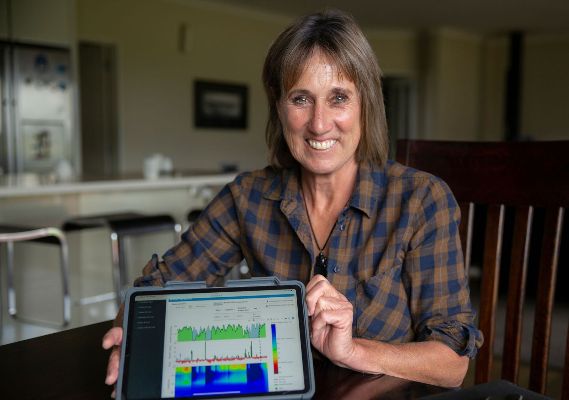Science And Genetics Boost Fernside Farm
Fernside dairy farmer Julie Bradshaw has applied learnings from a five-year National Institute of Water and Atmospheric Research (NIWA) irrigation study to make science-based decisions while also using genetics to improve her herd with the overall goal of reducing the farm’s environmental footprint.

Julie is participating in a six-month farming innovation project, which examines how the next generation of farmers are using innovative approaches to improve their farming practices. Waimakariri Landcare Trust (WLT) and Waimakariri Irrigation Limited (WIL) have partnered with the Ministry for Primary Industries (MPI) for the project, with support from MPI’s Sustainable Food and Fibre Futures fund along with Environment Canterbury, Ballance, and DairyNZ.
From 2016 to 2021 Julie and a group of five neighbouring farmers participated in a co-innovation study which provided landowners with real time data and forecasts to make science-based irrigation decisions.
The data included measured rainfall, soil moisture, soil temperature, drainage, and estimated evaporation as well as two, six and 15-day rainfall and weather forecasts.
Julie says the practical study gave each farmer a fantastic insight into their own land and irrigation practices while also providing a broader picture of what was happening in the catchment.
Having access to precise data has helped Julie and her neighbouring farmers to apply exactly the right amount of irrigation and fertiliser at the right time which helps to mitigate environmental impacts.
“It was amazing. We had so much data and information that we had never had before which has helped us make decisions about irrigation and fertiliser used that are backed up by facts and scientific data.
“Having the records also makes it much easier when it comes time for your FEPs and audits. We can show that we have been using our water resource correctly.”
All the farmers involved in the study were able to see each other’s data and this high level of transparency helped the group to understand what was happening in various parts of the catchment.
“We have always been very open. It is just information and data about water and getting to know more about other farms is helpful because we are learning from each other along the way.”
Although the study has ended, Julie still logs in to the group’s website most days to enable her to make accurate decisions about water allocation for the Cust Main Drain Water User’s Group. The group was established 25 years ago to manage water allocation during the irrigation season when water takes are restricted.
“It has been such a bonus to be able to see where everyone is sitting in terms of the moisture on their paddocks as this helps me to allocate the water more accurately to where it is needed. Not only do you see today’s moisture levels but you also get a future reading so you can see where things are heading.”
Last year Julie and her husband Peter received the Sire Proving Scheme Farmers of the Year Award from the Livestock Improvement Corporation (LIC). The couple have been working with LIC for 15 years and the award recognised their record keeping and commitment to having their entire herd DNA tested.
“We have a KiwiCross herd which is a cross between Holstein-Friesian and Jersey cows. I am really passionate about the ability of genetics to improve your overall herd quality. Having 99 per cent of the ancestry of the cows recorded is an immense help when doing the breeding.”
Julie believes that improving the overall quality of the herd means that if she needs to reduce her stock levels in the future, she knows exactly which animals have the best genetics to meet future farming limits. She is committed to using science to reduce her impact on local waterways.
“Genetics and DNA testing is so helpful when you think about the possibility of reducing herd numbers in the future. We must think ahead and use science to help us make the best decisions both for our business operation and for the environment.”
Throughout the course of the MPI innovation project Julie would like to learn more about genetics, while also improving the quality of the grass throughout the farm.
“We have three cows that LIC would like a bull calf out of so that will be an interesting process to follow.
“Another challenge is to improve the quality of our grass. With the colder and wetter spring that we had last year, followed by a cloudy and cooler summer our grass didn’t contain enough sugar and energy for the cows. We want to work on that throughout this project.”


 PSA: PPPs Pose Risks To New Zealand Workers
PSA: PPPs Pose Risks To New Zealand Workers Office of the Privacy Commissioner: New Research Shows Business Leaders Fear Being On The Hook For Others’ Privacy Breaches
Office of the Privacy Commissioner: New Research Shows Business Leaders Fear Being On The Hook For Others’ Privacy Breaches E Tū: E Tū Members Send Open Letter To James Grenon And NZME Board
E Tū: E Tū Members Send Open Letter To James Grenon And NZME Board Commerce Commission: Commission Calls For Comments On Copper Access Deregulation
Commerce Commission: Commission Calls For Comments On Copper Access Deregulation New Zealand Association of Scientists: NZAS Supports Saving Biotechnology Capacity In Callaghan; Asks What Now For Applied Technology Group
New Zealand Association of Scientists: NZAS Supports Saving Biotechnology Capacity In Callaghan; Asks What Now For Applied Technology Group Stats NZ: Business Employment Data - December 2024 Quarter
Stats NZ: Business Employment Data - December 2024 Quarter



